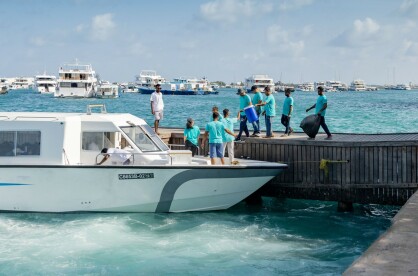Recognising the International Space Station
As the ISS nears retirement we take a look at the station's significance — and none too minor achievements.

Source - Getty Images
As the ISS nears retirement we take a look at the station's significance — and none too minor achievements.

Source - Getty Images
The International Space Station, or the ISS, has been a constant in the lives of the current generation, having been launched in the month of November in 1998. The young people of today know not a world without this bridge to the cosmos, and so it is important to tell the story of the ISS and be reminded of the determination of humanity in science and exploration.
It is the largest single structure humans have put into space, having housed over 244 individuals from 19 countries since the year 2000, and has a combined mass of 420 tonnes. By the scientific magic of content free-fall, the ISS zips around the Earth at a speed of about 28,000 km/h at an average height of 400 kilometres above the surface of the planet. This means the inhabitants of this impressive structure would orbit their home world every 90 minutes, capturing multiple sunrises and sunsets from their front row seats.
The ISS is a collaborative effort between Europe, the United States of America, Russia, Canada, and Japan; nations with advanced space exploration technology and dedicated budgets to reach the stars. Before it came to existence, space exploration was literally a space race, yet humanity holds a collective determination to reach the stars, and the ISS has been a culmination of these dreams.
The space station, including its large solar arrays, spans the area of an American Football field, including the end zones, and has a mass of 419,725 kilograms, not including visiting vehicles. The complex now has more liveable room than a conventional 6-bedroom house, and has 2 bathrooms, gym facilities and a 360-degree bay window. All this was built piece by piece, gradually put together in orbit using spacewalking astronauts and robotics.
This has been a continuous effort from 1998, starting off with the first module, the Russia Zarya, launched on November 20, 1998, on a Proton rocket. Two weeks later, space shuttle flight STS-88 launched the NASA Unity/Node 1 module. Astronauts performed spacewalks during STS-88 to connect the two parts of the station together.
Changing with the times, NASA began developing commercial cargo spacecraft sent to the space station under the Commercial Orbital Transportation Services program, which lasted from 2006 to 2013. Starting in 2012, the first commercial spacecraft, SpaceX's Dragon, made a visit to the space station. Visits continue today with Dragon and Orbital ATK's Antares spacecraft under NASA's Commercial Resupply Services program. In 2019, NASA executives announced that the space station would open its airlocks to commercial businesses and private astronauts. This allows the private sector to test out new technologies and train astronauts under microgravity
By being used as a platform for long-term research for human health, NASA proposes that this works as an important stepping stone in the much longer-term goal of exploring the solar system and beyond. Lunar and Martian exploration has been on the table for over half a century, and the findings on the ISS help shape these missions better. As the only microgravity laboratory in existence, the ISS has facilitated more than 3,600 researchers to conduct more than 2,500 experiments to date. They can test changes to the human body due to microgravity; such as alterations to bones, muscles, eyes, and the cardiovascular system, and the severity and nature of the changes.
To achieve this goal, multiple nations have sent up brave pioneers and researchers, and their numbers merit mention. Unsurprisingly the most frequent visits were by Americans — 155 people — followed by Russia with 52 cosmonauts. Other visitors include: Japan with 11, Canada with eight, Italy with five, France and Germany with four, and one each from Belgium, Netherlands, Sweden, Brazil, Denmark, Kazakhstan, Spain, Great Britain, Malaysia, South Africa, South Korea, and the United Arab Emirates.
Generally a seven member crew would be living and working aboard the ISS at any one time, spending six month stretches or more. Their schedule would include conducting various scientific experiments and maintenance of the ISS, with a mandatory two hour period daily for personal care and exercise. Microgravity deteriorates the muscles over extended periods being left unused, and so the exercise component using resistance elements help keep the astronauts in the best conditions possible, and able to survive back on planet-side.
The ISS has broke multiple records over its lifetime to date, and each of these achievements deserves celebration:
Retirement has always been on the table for the ISS according to NASA; the ISS was never a permanent program. Initially the procedure nor the date was confirmed, whether the structure was to be left in orbit and recycled for other projects, or jettisoned into deep space, and also whether to keep it running til 2024 or 2028. Now the decision has been made to crash the structure, in a controlled descent, into a relatively safe region of the Pacific Ocean, by the year 2030.
NASA claims that they will be able to save up to USD1.8 billion annually, as they already spend roughly USD3.1 billion to support the ISS program yearly. USD1.3 billion from this total amount is spent on mission control and research, while the remaining, stellar chunk of money goes into crew and transportation. In turn, reports estimate that NASA would be supporting, with about a USD1 billion, annual expense for the commercial low Earth orbit destination services through the Commercial LEO Destinations (CLD) program, with the rest of the savings diverted to more deep space exploration initiatives.
The reasoning for this decision is not entirely supported by financial gain; the technology that has been used and is being used currently is becoming outdated, as the development on the surface of the planet, both commercial and state-funded, has been evolving exponentially. Especially with the SpaceX program and their reusable rockets — increased carrying capacities hint at much further reach than the 400 km above planet-side, and also the newly established, ‘third-step’ of the Chinese space exploration program, the Tiangong Space Station, armed with the latest cutting-edge technology clearly outpacing the ISS.
However, with the retirement of the ISS, a bright light that has zipped across the night skies of humanity for over 24 years will be seen no more. Testament to humanities’ curiosity for what lies beyond the clouds, the ISS has served as a crucial step in the stairway to heaven, allowing civilisation to understand a little bit more what was never understood before.
With the final phasing out plans in 2028/30, there will come a day when the last human would step aboard this bridge between the Earth and the cosmos, but the lessons learnt on the structure, the time spent in the harshest of environmental conditions, will hopefully prepare mankind for life a life of exploration — and possibly life elsewhere.



